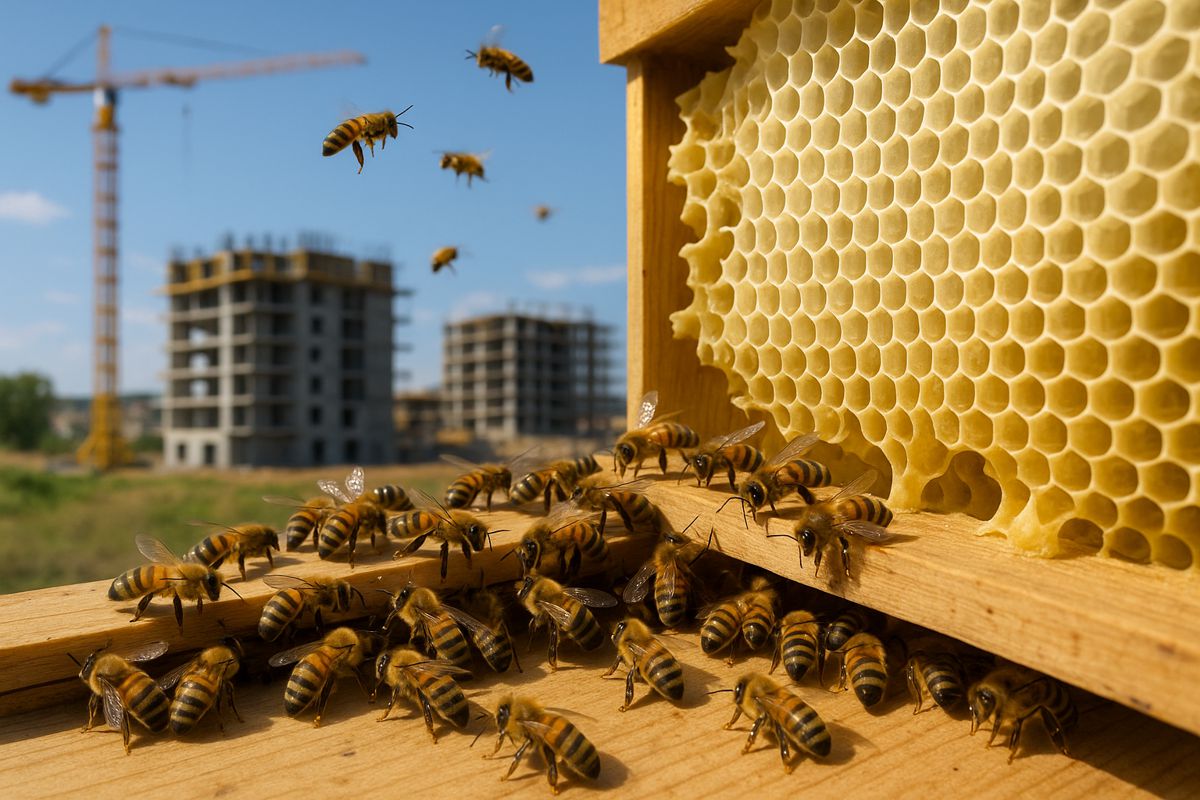Building Wisdom from Bees
On a sweltering Colorado afternoon, European honeybees (Apis mellifera L.) spiral above a cluster of hives near Boulder Creek. Some dart out in search of water, nectar and pollen, while others return with bulging saddlebags of resources. Beneath this whirling choreography, a remarkable building project takes shape. Inside each hive, sheets of honeycomb slowly emerge, their hexagonal walls pressed together with a precision that astonishes even seasoned scientists.
Orit Peleg, associate professor in CU Boulder’s Department of Computer Science, has long admired the collective intelligence at work in these tiny creatures. She said: “Building a hive is a beautiful example of honeybees solving a problem collectively. Each bee has a little bit of wax, and each bee knows where to deposit it, but we know very little about how they make these decisions.”
In August 2025, Peleg’s research group partnered with aerospace engineering specialist Francisco López Jiménez and his team to explore that mystery further. Their study, published in PLOS Biology, sheds new light on how bees construct comb in challenging environments and could inspire new thinking in construction engineering, aerospace design and additive manufacturing.
Why Honeycomb Matters
Honeybees adapt their nest construction to almost any setting, from commercial hive boxes to hollow trees and even the occasional derelict attic. Regardless of location, they build their homes from honeycomb, a wax-based structure formed from densely packed hexagonal cells.
The hive’s geometry is anything but accidental. Workers shape honeycomb to store food and nurture brood, relying on hexagons because they deliver maximum structural efficiency. In mathematics and biology, hexagons offer the optimal ratio of storage capacity to construction material; no other shape uses less wax while supplying such strength.
Yet honeycomb is resource intensive to make. Bees spend the warm months collecting nectar, mixing it with enzymes and storing it until it thickens into honey. It takes around two million flower visits to produce a single pound of honey. Worse still, a worker bee must consume roughly eight ounces of honey to produce just one ounce of wax. Any inefficiency in construction therefore carries a stubborn cost.
When bees must anchor comb to irregular surfaces, those costs rise. Cells become misshapen, storage capacity drops and colony productivity suffers. Understanding how bees respond to such constraints has become a key focus for engineers searching for novel construction strategies based on natural systems.
Setting Bees A Structural Challenge
The Colorado team set out to analyse how bees adapt their building behaviour when confronted with irregular foundations. Lead author Golnar Gharooni Fard, then a graduate student, explained her aim for the project: “We wanted to find the rules of decision-making in a distributed colony.”
The researchers used 3D printing to create hive panels imprinted with shallow hexagonal patterns. Some displayed larger-than-normal cells, others smaller, and some reflected an average size. The team then added these foundations to active hives and observed how the bees responded.
Once the bees began to build, the researchers used X-ray microscopy to examine the internal structure of the resulting comb. The images revealed an astonishing range of adaptations. Depending on the geometry presented, the bees merged adjacent cells, rotated the cell angles or layered cells vertically when required.
López Jiménez described this as a natural puzzle: “All those things happen in nature. If they’re building honeycomb on a tree, and at some point they get to the end of the branch, the branch might not be super flat, and they need to figure that out.”
These results reinforced what engineers have observed across biology. When faced with spatial constraints, organisms often improvise elegant solutions. Bees, with their decentralised workforce and limited individual tasks, appear especially adept at problem-solving through distributed decision-making.
What Engineers Can Learn From Honeybees
Although honeycomb has long inspired construction, aerospace and materials science, this study offers fresh evidence that bees’ behaviour, not merely their architecture, holds valuable lessons for human industry.
The first lesson centres on distributed labour. In construction engineering and robotics, researchers continue exploring ways to coordinate multiple agents without centralised control. Bees provide a compelling proof of concept. Each worker adds minute fragments of wax to a larger structure, making local decisions that ultimately create a coherent whole.
López Jiménez noted: “The bees take turns, and they organise themselves, and we don’t know how that happens. Can we learn from how the bees organise labour or how they distribute themselves?”
For the construction sector, such insights could influence modular building systems, robotic assembly, automated surveying and even emergency response. If machines could operate with bee-like autonomy, construction sites could become safer, more efficient and less dependent on human oversight.
A second lesson lies in the bees’ structural adaptations. Engineers developing lightweight materials already use honeycomb architectures in aerospace components, façade systems, insulation and crash-resistant infrastructure. Understanding how bees adjust the geometry of each cell in real time could inspire new approaches to variable-density materials, adaptive structures and parametric design.
Researchers are particularly intrigued by how bees manage transitions between irregular and regular comb. In many constructions, these transitions become weak points. Bees appear to smooth such boundaries with remarkable fluidity. Translating this behaviour into digital modelling tools could benefit architects working with complex geometries.
Implications For 3D Printing And Additive Manufacturing
Another promising area involves additive manufacturing. Bees essentially perform a form of natural 3D printing. They deposit wax one particle at a time, layering sections in a process strikingly similar to fused deposition modelling.
Modern 3D printers struggle when encountering irregular bases or incomplete layers. Bees, by contrast, manage these inconsistencies with surprising ease. Researchers believe their construction strategies could inform algorithms for corrective layer deposition, adaptive nozzle paths and materials that respond dynamically to environmental constraints.
The implications ripple outward to infrastructure construction, where printed concrete and robotic fabricators are becoming increasingly common. Learning how bees regulate consistency and geometry across varied surfaces may one day help engineers overcome common constraints in large-scale additive manufacturing.
Looking Toward Bio-Inspired Construction Futures
The team’s work, which also included CU graduate student Chethan Kavaraganahalli Prasanna, has opened new lines of inquiry. Many questions remain unanswered, particularly regarding how bees coordinate without central oversight. Researchers plan to investigate how the insects communicate locally, how they sense structural irregularities and whether spatial memory plays a role.
Across the construction industry, interest in bio-inspired innovation is accelerating. From termite-inspired ventilation systems to plant-based composite materials, engineers increasingly look to nature’s long-evolved solutions for guidance. Honeybees, with their collectivist efficiency and architectural sophistication, may soon influence the next generation of building technologies.
Ultimately, the Colorado study offers more than a glimpse into insect behaviour. It provides a framework for approaching complex construction problems. By examining how bees build harmoniously under pressure, researchers and engineers may discover fresh strategies for sustainable, efficient and resilient infrastructure.
Moving Forward With Nature’s Lessons
As research continues, one message is clear. The ingenuity observed in honeybee colonies has genuine potential to shape human construction practices. Their distributed decision-making, geometric precision and adaptive problem-solving offer a blueprint for future technologies that combine efficiency with elegance.
Nature, when studied through an engineering lens, often reveals design principles that outperform conventional methods. Bees, as it turns out, are not only master builders but also patient teachers, offering insights that could transform the way infrastructure is conceived and created.




















